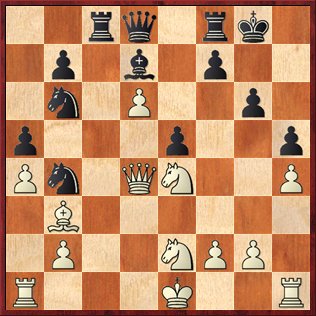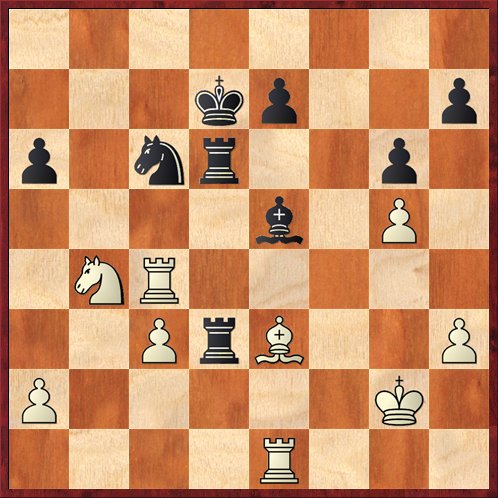Last night Mike Splane was showing me and Gjon Feinstein a game he played in the New Year Open, and we got to this position.
White to move.
Black, a young player named Richard Yi, has just played 18. … e5!, a move that Michael says that he completely overlooked. At first Mike thought it was just a desperate move and he was planning to take the pawn. But then, he said, he realized that “My opponent was too quiet.” Mike took a closer look at the position, and realized that his opponent was just waiting for 19. Qxe5?? so that he could pounce with 19. … Nd3+!
So in the game, Mike played, 19. Qe3?, which I believe is still a mistake. Black just needs to defend the h6 square with 19. … Kg7, and then White has real problems because of all the forking possibilites. 20. Nc5? would be an amusing blunder because after 20. … Rxc5! 21. Qxc5 Nd3+ White has fallen into another version of the same fork. Mike says that he was planning to respond to 19. … Kg7 with 20. N2c3, but it seems to me that White is practically busted after 20. … Be6! White can’t take the bishop because of … Nc2+, and after the abject 21. Bd1, Nc4 is just horrifying.
Yi, however, did not play the necessary prophylactic move. Instead he played 19. … N7d5?? and went down in flames after 20. Qh6!
But what interests me about this story is the way that Mike avoided the trap. His opponent was “too quiet” — in other words, what tipped him off was, to use poker terminology, a “tell.”
Have any of you ever won a game or averted a loss because of a tell? I can think of one recent tournament game I played where a tell made a small difference, although I don’t think it actually changed the outcome.
Black to move.
This is from my only game with Daniel Naroditsky, from the Western States Open in Reno (2009). Danya was Black. It had been an intense battle, where I played too “coffeehouse style” in the opening and barely survived, but then fought back to get a playable position, only to make another mistake and spoil it. In the position above, Black can win the c3 pawn. But which way should he take it?
The answer is that he should play 29. … Rxc3. There’s just one little trick he has to watch out for: After 30. Nxc6 he should not take the rook, because 30. … Rxc4? would run into 31. Nxe5+. Instead he should play 30. … Rxc6, and then he is simply a pawn up with an almost certainly won endgame.
I don’t know whether Danya got scared by that little trick or whether he miscalculated, but in any case he played 29. … Bxc3?? instead. And the instant he let go of the bishop, he saw why it was a blunder. His face dropped and his shoulders slumped — just for an instant, but I had my “tell.”
As I said, I don’t think that it affected the outcome of the game. I would certainly have played 30. Nxd3 anyway, but because of Danya’s reaction I knew that I was winning material, not falling into a trap. I checked anyway just to make sure, and then I played 30. Nxd3 Rxd3 (not 30. … Bxe1 31. Nxe1 — the latter being the move that Danya had probably missed in his analysis, a tactical motif I call the “hit and run”) 31. Re2 e5.
Here Danya offered a draw, and I accepted. There were several reasons for accepting. First, though White is up the exchange for a pawn, Black’s pieces are really active, so the position is dangerous. Second, I had less than 5 minutes left for 9 moves. In that situation, I didn’t want to get greedy and end up losing.
Of course, you can’t always rely on tells. One local player/chess hustler, Steven Sullivan, would very often gasp or slap his forehead when he made a “blunder” in a time scramble (which would really be a trap). It was always so obvious and he did it so often that I don’t think I ever actually fell into one of his traps. Over time I came to look forward to his charades as a kind of performance art.
Leaving known hustlers aside, though, I can’t remember getting a game-changing tell from an adult player in a tournament game. It’s interesting that both of the examples above, with Yi and Naroditsky, involved teenage players. Are younger players more prone to this kind of emotional blunder?
Have any of you heard any good stories about tells in master-level play?





{ 4 comments… read them below or add one }
Hey Dana! Once again, great article, but I would like to offer you an alternate line in Mr. Splane’s game. I’m not so sure if this is the best line (as it’s 2:44 a.m. and i’m still putting off college homework), but after Qe3, can’t black force a series of moves with Nc2+?
So after 19…nc2+ 20. Bxc2 Rxc2, White’s move 21. Qh6 no longer works because black now has the prophylactic move Nd5! to prevent any Nf6 funny business. I think Kg7 is the most logical, but black has a very decent position after 20. Rxc2.
Black’s light square bishop can find a nice home on f4, black can still play Kg7 I think if white opts not to do Qh6. White’s king will probably be stuck in the center for the rest of the game because of Qxh4, and anything a move to defend it is way to slow in a dynamic position such as this one. Maybe.
Anyways, I think I’ll get back to doing my engineering homework and hopefully my analysis is somewhat accurate and of help.
Cheers,
Alex Ding
Oh sorry for a double post, but I just realized a slight error in what i posted. I didn’t mean Nd5 was to prevent Nf6, but to prevent white’s Ng5 threat WITH Nf6. Sorry about that.
Hi Alex,
Good points! Another good feature of 19. … Nxc2+ 20. Bxc2 Rxc2 is that it takes White’s bishop off the b3-g8 diagonal, so after 21. Qh6 there are no threats of Qxg6+. Black’s position looks much better. (Oh, and by the way — I understood what you meant about … Nf6. Actually later in the game, if I remember correctly, White had some serious threats of playing Nf6 too, so your original wording actually made some sense!)
Hey Dana,
Sorry if the question is naive, but here it goes anyway: Is there a way to transfer the pictures of the positions to a chess program such as ChessBase Reader? If not, could you print the moves leading to the position(s) so we can follow your comments? Thank you very much. By the way, I miss your lectures at ChessLecture. When are you going to post a new one?
Have a great 2012! Congrats on new book and cat! Life’s good, right?